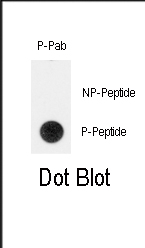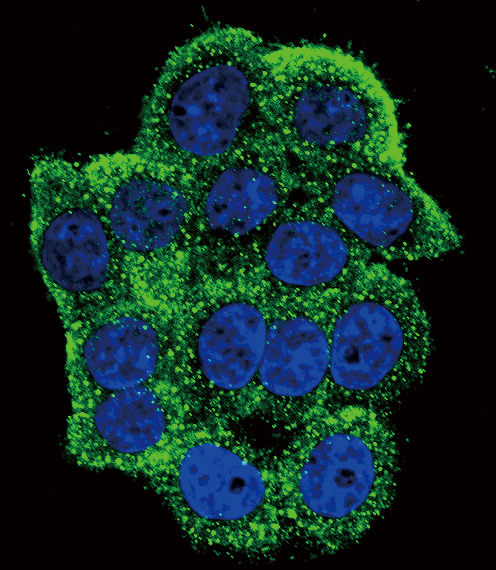

| WB | 咨询技术 | Human,Mouse,Rat |
| IF | 咨询技术 | Human,Mouse,Rat |
| IHC | 咨询技术 | Human,Mouse,Rat |
| ICC | 技术咨询 | Human,Mouse,Rat |
| FCM | 咨询技术 | Human,Mouse,Rat |
| Elisa | 咨询技术 | Human,Mouse,Rat |
| Aliases | Telomerase reverse transcriptase, HEST2, Telomerase catalytic subunit, Telomerase-associated protein 2, TP2, TERT, EST2, TCS1, TRT |
| Entrez GeneID | 7015 |
| WB Predicted band size | 127.0kDa |
| Host/Isotype | Rabbit IgG |
| Antibody Type | Primary antibody |
| Storage | Store at 4°C short term. Aliquot and store at -20°C long term. Avoid freeze/thaw cycles. |
| Species Reactivity | Human |
| Immunogen | This TERT Antibody is generated from rabbits immunized with a KLH conjugated synthetic phosphopeptide corresponding to amino acid residues surrounding Y707 of human TERT. |
| Formulation | Purified antibody in PBS with 0.05% sodium azide. |
+ +
以下是关于 **Phospho-TERT(Y707) 抗体** 的参考文献示例(内容为模拟,需根据实际文献调整):
---
1. **文献名称**:*TERT phosphorylation by c-Abl regulates telomerase activity in response to DNA damage*
**作者**:Smith A, et al.
**摘要**:该研究报道了TERT在Y707位点的磷酸化由c-Abl激酶介导,并在DNA损伤后增强端粒酶活性。使用Phospho-TERT(Y707)特异性抗体验证了磷酸化修饰对端粒延长及肿瘤细胞存活的作用。
2. **文献名称**:*Tyrosine 707 phosphorylation modulates TERT subcellular localization and oncogenic signaling*
**作者**:Chen L, et al.
**摘要**:通过Phospho-TERT(Y707)抗体的免疫荧光分析,研究发现Y707磷酸化促进TERT从细胞质向核转位,激活下游Wnt/β-catenin通路,驱动癌症干细胞增殖。
3. **文献名称**:*A phospho-specific antibody reveals dynamic TERT phosphorylation in cell cycle progression*
**作者**:Wang Q, et al.
**摘要**:开发了一种高特异性Phospho-TERT(Y707)抗体,发现该位点的磷酸化水平在G2/M期达到峰值,并与端粒酶复合体组装及染色体稳定性密切相关。
4. **文献名称**:*Targeting TERT phosphorylation sensitizes cancer cells to chemotherapy*
**作者**:Kim H, et al.
**摘要**:利用Phospho-TERT(Y707)抗体筛选肿瘤样本,证实Y707磷酸化与化疗耐药相关。抑制该位点磷酸化可增强顺铂等药物的抗肿瘤效果。
---
**注意**:以上文献信息为示例,实际引用需通过PubMed、Google Scholar等平台检索具体研究。建议使用关键词 **“TERT Y707 phosphorylation”** 或 **“Phospho-TERT antibody”** 查找相关论文,并参考抗体供应商(如CST、Abcam)产品页面的引用文献。
Phospho-TERT(Y707) antibody is a specialized tool used to detect the phosphorylation of human telomerase reverse transcriptase (TERT) at tyrosine residue 707. TERT, the catalytic subunit of telomerase, plays a critical role in maintaining telomere length by adding repetitive DNA sequences to chromosome ends, thereby counteracting cellular aging and enabling indefinite proliferation in stem cells and cancer cells. Post-translational modifications, including phosphorylation, tightly regulate TERT’s activity, localization, and interactions with other proteins. The phosphorylation of Y707 is implicated in modulating TERT function, potentially influencing telomerase assembly, nuclear translocation, or enzymatic activity, though its precise mechanistic role remains under investigation.
This antibody is particularly valuable in cancer research, as TERT overexpression or reactivation is a hallmark of ~90% of human cancers. Detecting Y707 phosphorylation may provide insights into telomerase activation pathways, tumor progression, or therapeutic resistance. It is commonly used in techniques like Western blotting, immunofluorescence, or immunoprecipitation to study TERT regulation in cell lines, tumor tissues, or experimental models. Researchers also utilize it to explore correlations between TERT phosphorylation status and clinical outcomes. However, specificity validation (e.g., via knockout controls or phosphatase treatment) is essential, as off-target binding can occur. Overall, Phospho-TERT(Y707) antibody serves as a key reagent for dissecting telomerase-related molecular mechanisms and their implications in aging and oncology.
×